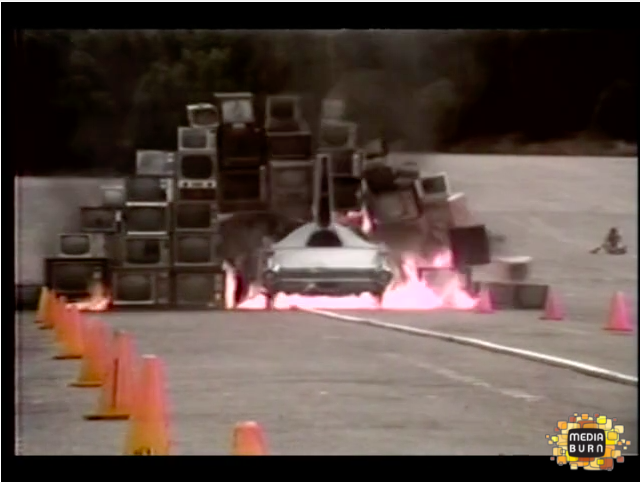I was radicalized by watching hundreds of hours of camera original video tape at the Media Burn Independent Video Archive. Like any true convert, I believe that watching Media Burn’s tapes changed my life and think that watching their tapes can change your life, too.
When I first came to Media Burn, I thought that being well-informed meant reading as many high quality news outlets as I could. Yet as I watched more unedited documentary video, I realized that, informative as they were, these mainstream products were highly processed. I began to see the raw video as a new primary source for history. The way I consume media was radicalized by my experience in the archive. And with changed perceptions of media, my understanding of society changed.

Media Burn’s collection represents a shared belief among dozens of video makers in the power of independent documentaries. This shared belief has its roots in the countercultural movement.
“Media Burn” is a concept coined in the early 70s by Tom Weinberg, the archive’s founder, to explain what happens to a person after they become famous. On July 4, 1975, at Cow Palace Stadium in San Francisco, the video collective Ant Farm used “Media Burn” as a title for a performance art event.
The event featured Doug Michels and Curtis Schreier piloting a modified 1959 Cadillac El Dorado Biarritz into a pyramid of televisions that had been doused in kerosene and set ablaze. “Media Burn” is also the title of the video produced for the event. The name reflects the archive’s goal of using art playfully yet thoughtfully in order to examine culture. In 2006 and 2014 , when Media Burn hosted fundraisers on the roof of the garage at Wabash and Randolph, they built a TV pyramid. The installation made an explicit link to the 1975 performance art event. In this way, Media Burn has its roots in radical counterculture.
Back in 1975, Ant Farm’s event was recorded on a U-Matic camera, the second generation of portable video after the ½” Porta-Pak. The Porta-Pak was the first technology of our social media era. Unlike the camera equipment of a broadcast television studio, the Porta-Pak miniaturized the technology so that video recording was small enough to carry on your shoulder and hold in your hands. And, crucially, unlike film, the magnetic video tape itself was re-writable. Especially crucial for documentary, the longer running times of tapes — a whole 30 minutes compared to film’s 5 minutes of running time — meant you could record an event for a long period of time and then tape over the content if nothing happened. This technological difference gave power to people who would otherwise never gain access to major production studios.
The archive’s videos were recorded on this hand-held technology and its offspring. The videos themselves come from many different genres. In this way, you’re sure to find some content that caters to your interests. Love baseball? Watch Bill Veeck tying one on. Love animation? Watch this curated video of works by the Chicago-based pioneers of image processing. Love politics? Watch this 35-second spot for Harold Washington’s 1983 Mayoral campaign. Want more radical content? Browse videos using the archive’s “outside agitators” and “guerrilla television” tags.

For every hour of content available online it took an archivist 5 hours to fully describe, catalog, and digitize.
Cataloging and transcribing are slow, contemplative disciplines. With cataloging, an archivist uncovers themes and creates keywords with other people in mind. A good finding aide can take years to complete. Cataloging is decidedly not about what interests the archivist personally, but rather about trying to predict what someone might consider important in the future. To do this effectively, while watching video, an archivist trains their internal dialogue to shift from, “Do I like this?” to “What’s in this?” and “Who might find this important?” It is an empathetic practice.
Video that’s called “camera original” was created as part of a longer production process. The majority of what’s recorded, however, likely won’t make it into the final cut. B-roll and outtakes are camera original. By watching camera original video, archivists learn to watch video like you might watch the wind blowing fallen leaves in the park. Attentive, but without the expectation of narrative rhythm or a final denouement. Watching camera original tape often means watching the world unfold in real time.
For those of us addicted to our social media feeds, the video archivist’s discipline is a powerful alternative to mindless scrolling. Social media’s equivalent to the slow food movement is available to you through Media Burn. It means thinking of others and slowing down to real time.
About the Writer: At Media Burn, Andrew Seeder transcribed and cataloged 64 camera original video tapes from Ronit Bezalel’s “Voices of Cabrini” documentary. He has also transcribed an English translation of Euclid’s “Elements,” volumes of which were on display in 2012 for the University of Chicago’s Special Collections Research Center’s exhibit On the Edge: Medieval Margins and the Margins of Academic Life.

0 Comments
You can be the first one to leave a comment.